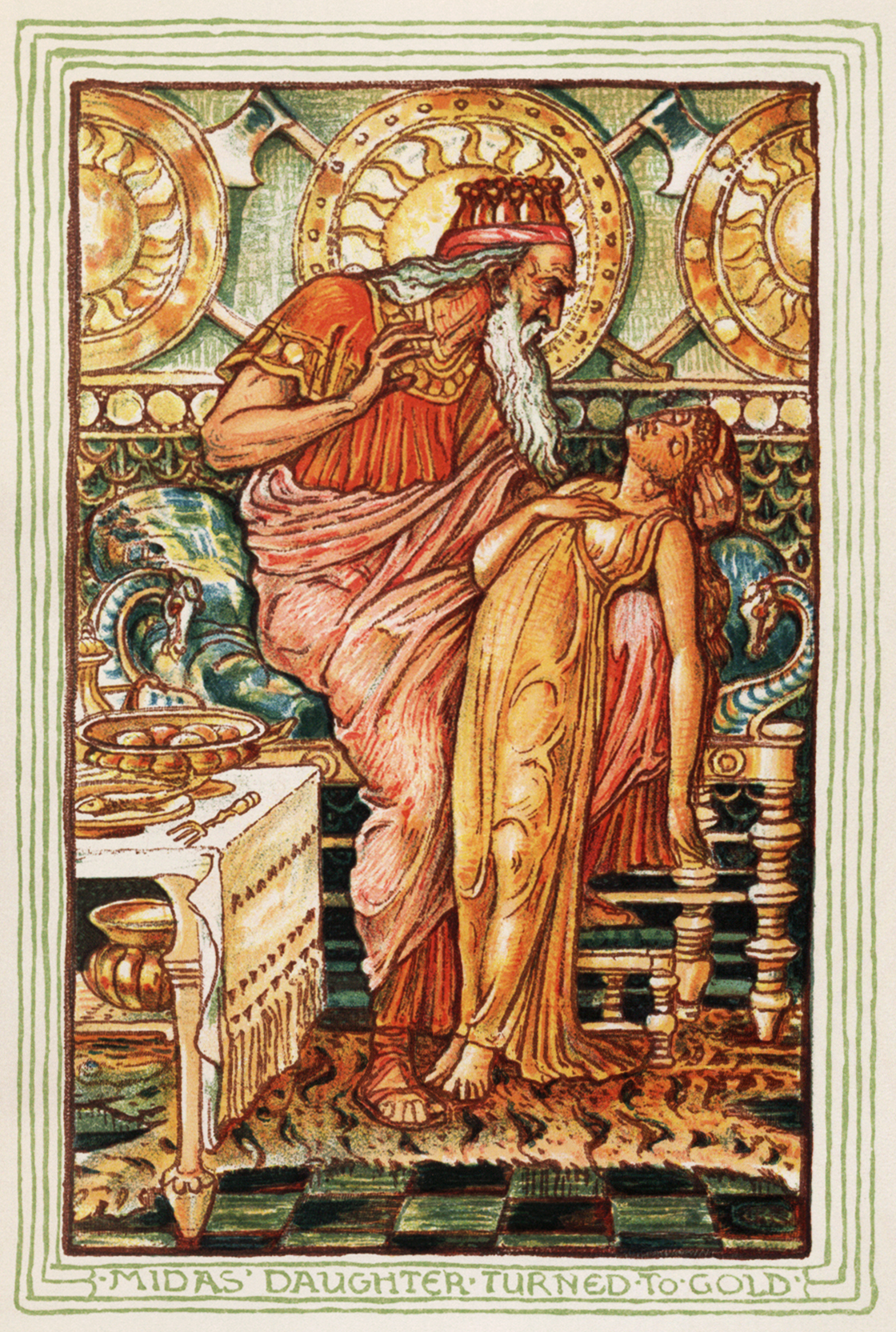According to myth, Dionysus granted King Midas the ability to turn anything he touched to gold. All this seemed like a good idea until he accidentally turned his food, drink, and daughter into gold. (No word on how Mrs. Midas felt about any of this.) This fable seems to be missing an important ingredient: shouldn’t he be turning air into gold as well? How much air would Midas turn to gold each second?
Knowing some simple physics will help us immensely with this problem. First off, air molecules are constantly in motion, which means they’re constantly bouncing off old Goldy McGoldypants. Each time they bounce off him, the air molecules turn into gold and presumably precipitate into gold dust that falls to the ground. Each air molecule is moving with some kinetic energy—the energy of motion—where the kinetic energy KE is given by,
Knowing some simple physics will help us immensely with this problem. First off, air molecules are constantly in motion, which means they’re constantly bouncing off old Goldy McGoldypants. Each time they bounce off him, the air molecules turn into gold and presumably precipitate into gold dust that falls to the ground. Each air molecule is moving with some kinetic energy—the energy of motion—where the kinetic energy KE is given by,
KE = m v2 / 2,
where m is the mass of the molecule and v is the velocity or speed of the particle. From thermodynamics, it is known that the mean kinetic energy of a molecule is given by,
KE = 3 kB T / 2,
where, kB = 1.38×10-23 J K-1 is Boltzmann’s constant and T=298 K is room temperature. Most of the air is made of nitrogen gas, which has a mass of 4.6×10-26 kg. From this info, we can solve for the average speed of the particles,
v = (3 kB T / m)1/2
= [ 3 · (1.38×10-23 J K-1) · (298 K) / (4.6×10-26 kg) ] 1/2
= 520 m/s.
= 520 m/s.
At that speed, we’d expect a lot of air to collide with Midas. If Midas is 1.8 m tall and 0.6 m wide, then he has a cross sectional area of 1.1 m2. The number of collisions will be roughly equal to the number of molecules passing through this area. Using the velocity above and the density of air, we can compute the mass of molecules bouncing off Midas each second,
mass = (density of air) · (cross section area) · (speed of molecule)
= (1.2 kg/m3) · (1.1 m2) · (520 m/s)
= 690 kg/s.
If the air-to-gold reaction obeys mass conservation, Midas would be generating 690 kg each second. Admittedly, his lungs would almost instantly fill up gold.
Counterpoint: Your Fermi sense may be tingling. This number seems too large. After all, this would mean that all the molecules in a fairly large room (i.e. a room with a volume of about 500 m3) would collide with Midas in one second! That seems very unlikely. We may have simplified too much. The reason is that while each molecule is moving at about 520 m/s, they are constantly bouncing off of each other so that their net speed is much less than this. (To learn more, click here.) Complicating things even more is the fact that Midas is essentially creating a vacuum by removing molecules from the air. In addition to sucking more molecules towards him, this will decrease the pressure, which may in turn lower the temperature of the room. In any event, it’s a much more complicated problem than we’re treating here. If you think you can do a better job, feel free to post your own solution. I’m curious to see what others come up with.
Counterpoint: Your Fermi sense may be tingling. This number seems too large. After all, this would mean that all the molecules in a fairly large room (i.e. a room with a volume of about 500 m3) would collide with Midas in one second! That seems very unlikely. We may have simplified too much. The reason is that while each molecule is moving at about 520 m/s, they are constantly bouncing off of each other so that their net speed is much less than this. (To learn more, click here.) Complicating things even more is the fact that Midas is essentially creating a vacuum by removing molecules from the air. In addition to sucking more molecules towards him, this will decrease the pressure, which may in turn lower the temperature of the room. In any event, it’s a much more complicated problem than we’re treating here. If you think you can do a better job, feel free to post your own solution. I’m curious to see what others come up with.


Air pressure at sea level is 101,325 N/m^2. The human skin is about 2 m^2. This means the air around us is exerting a total force of 202,650 N and that means that our skin is pushing back on the air with the same force.
ReplyDeleteWe assume that the air molecules hit the skin turn to gold and come to a complete stop. We can calculate that skin exerting the force listed about can bring a 390 kg mass traveling at 520 m/s to a stop in 1 second.
390 kg of gold would make an 11 inch cube and sell for $13.8 million. 390 kg of air would make a 22.4 foot cube.